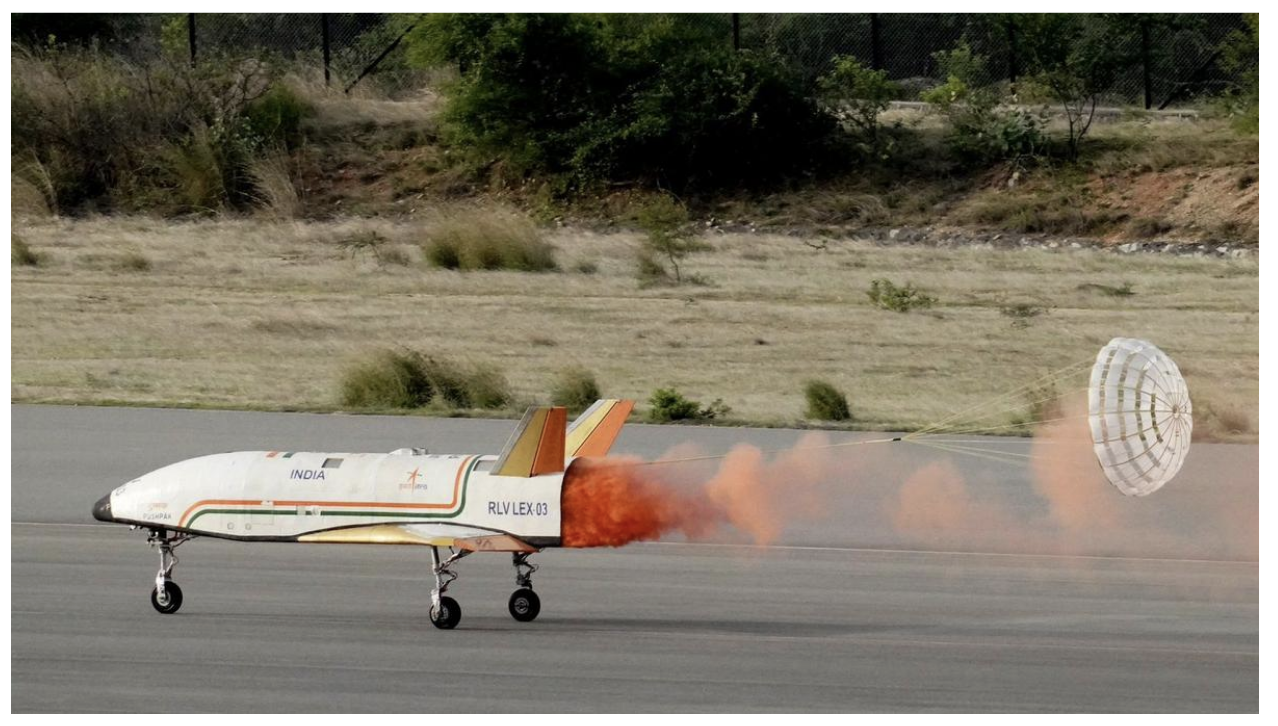News Excerpt:
The Indian Space Research Organisation (ISRO) completed the third Reusable Launch Vehicle (RLV) Landing Experiment (LEX) at the Aeronautical Test Range (ATR) in Chitradurga, Karnatak.

About Pushpak, LEX (03):
- Mission Overview: This is the third and final test in the series of LEX (03) Known as RLV LEX-03, this mission aimed to demonstrate the autonomous landing capability of the Reusable Launch Vehicle (RLV) under more challenging conditions following the successes of previous missions, RLV LEX-01 and LEX-02.
- Release and Altitude: Pushpak, the winged vehicle, was released from an Indian Air Force Chinook Helicopter at an altitude of 4.5 km.
- Autonomous Operations: Pushpak autonomously executed cross-range correction maneuvers. It approached the runway and successfully performed a precise horizontal landing at the runway centerline.
- Landing Velocity: Due to its low lift-to-drag ratio aerodynamic configuration, Pushpak achieved a landing velocity exceeding 320 kmph.
- This velocity is higher compared to commercial aircraft (260 kmph) and typical fighter aircraft (280 kmph).
- Deceleration Process: Post touchdown, Pushpak deployed a brake parachute to reduce its velocity to nearly 100 kmph. Subsequently, it utilized its landing gear brakes for further deceleration and eventual stop on the runway.
- Ground Roll Phase: During the ground roll phase, Pushpak autonomously utilized its rudder and nose wheel steering system to maintain a stable and precise trajectory along the runway.
- Technological Validation: The mission validated advanced guidance algorithms crucial for correcting longitudinal and lateral plane errors, essential for future orbital re-entry missions.
- Sensor Fusion: Pushpak utilized multisensor fusion technology, incorporating sensors such as inertial sensors, radar altimeter, flush air data system, Pseudolite system, and NavIC (Navigation with Indian Constellation).
- Reusability Demonstration: Remarkably, RLV LEX-03 reused the same winged body and flight systems from the LEX-02 mission without modification. This demonstrates ISRO's capability and robustness in designing reusable flight systems for multiple missions.
- Significance for RLV Development: The mission simulated high-speed landing conditions that a vehicle returning from space would encounter. This simulation reaffirms ISRO's expertise in acquiring critical technologies necessary for the development of a Reusable Launch Vehicle (RLV).
What is RLV?
- An RLV is a vehicle that is launched into space many times. As the vehicle can be used for many relaunches, it goes a long way in mitigating costs.
- The idea of a re-usable landing vehicle was mooted to regain super expensive rocket boosters that are used for launching spacecraft. It could be later used to refuel and reuse in space flights.
How are RLV LEX-01 and RLV LEX-02 similar to and different from each other?
- The flight systems and the wing body used in the first leg of RLV LEX were reused for RLV LEX-02.
- After evaluating the results of the first experiment, ISRO made some improvements such as strengthening the airframe structure and landing gear so that Pushpak can tolerate higher landing loads during RLV LEX-02.
- The difference between RLV LEX-01 and RLV LEX-02 is that in the first leg of the autonomous landing mission, Pushpak was released mid-air after certain predetermined conditions were achieved. Meanwhile, for RLV LEX-02, Pushpak was subject to off-nominal conditions.
- Therefore, not only did ISRO successfully accomplish the autonomous landing of a reusable launch vehicle prototype, but also demonstrated reuse capabilities of flight hardware and flight systems.


